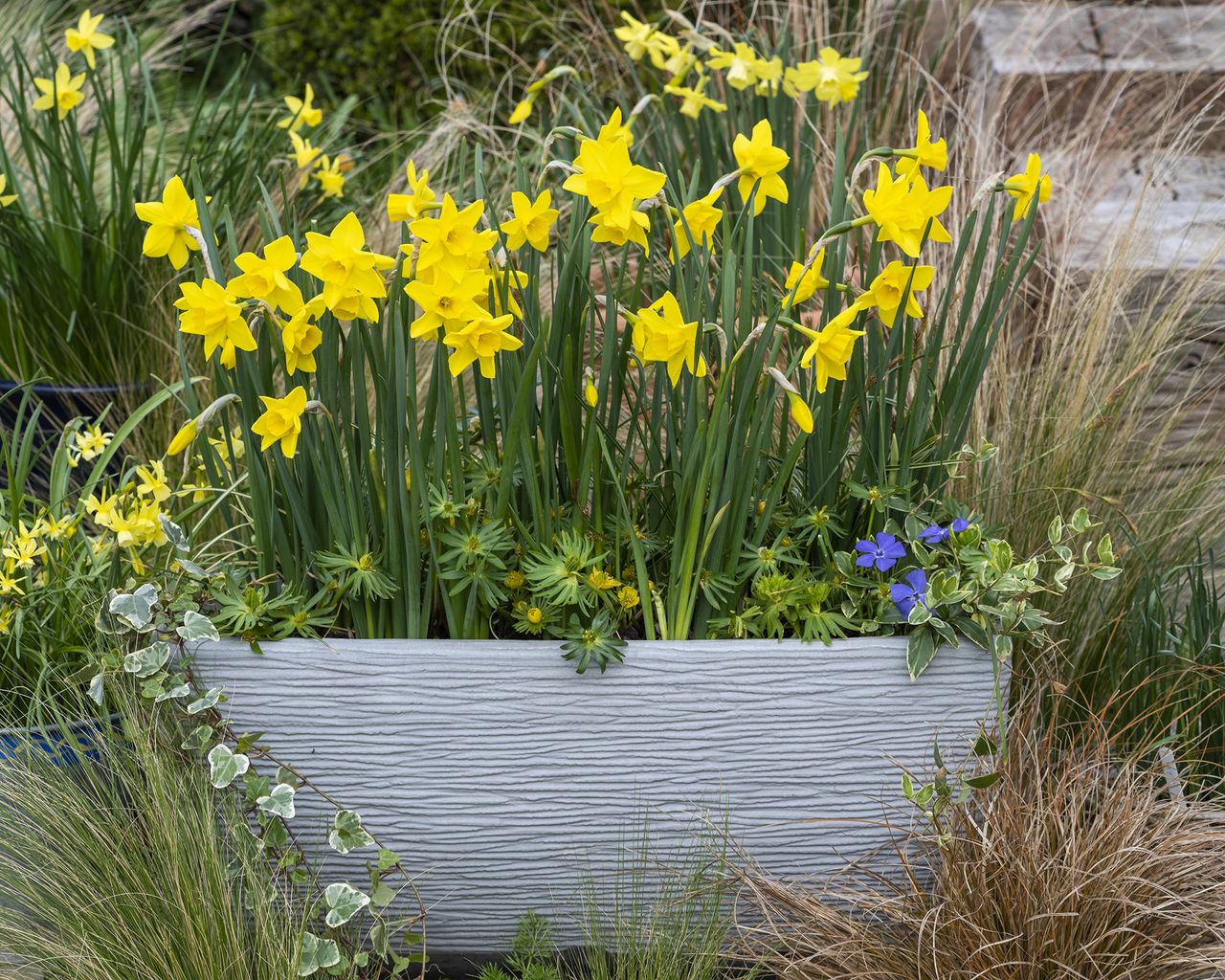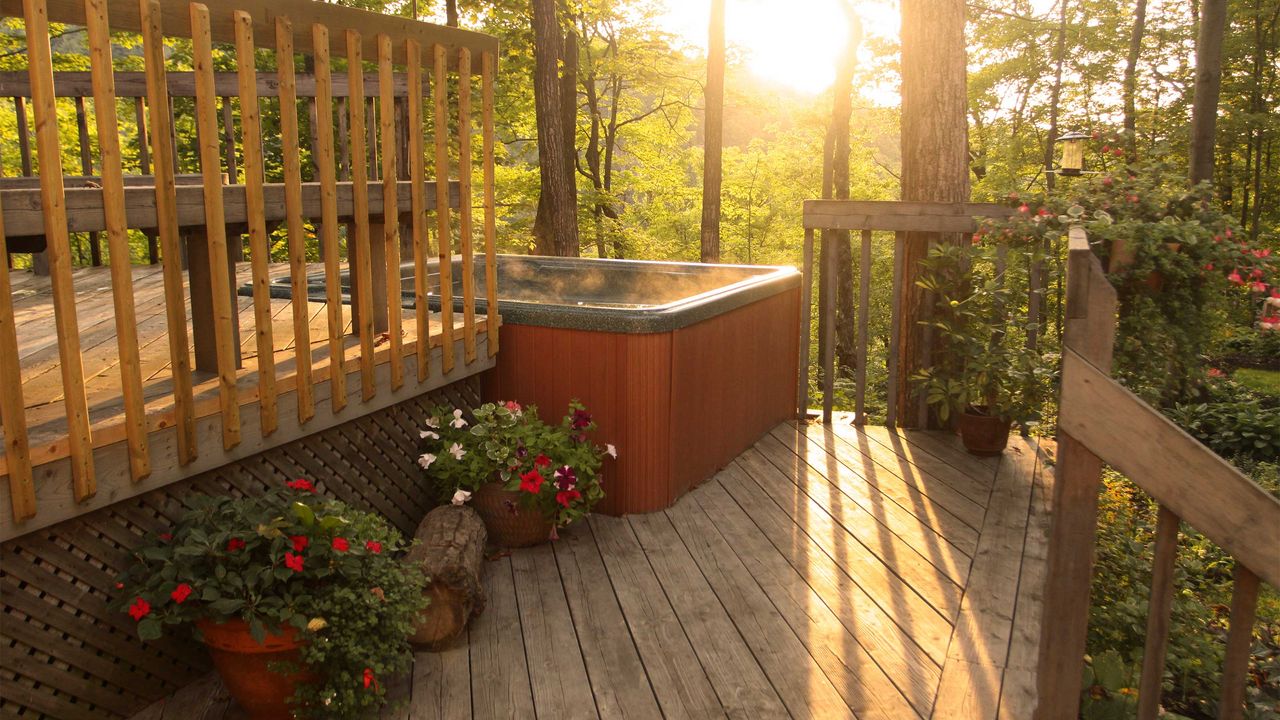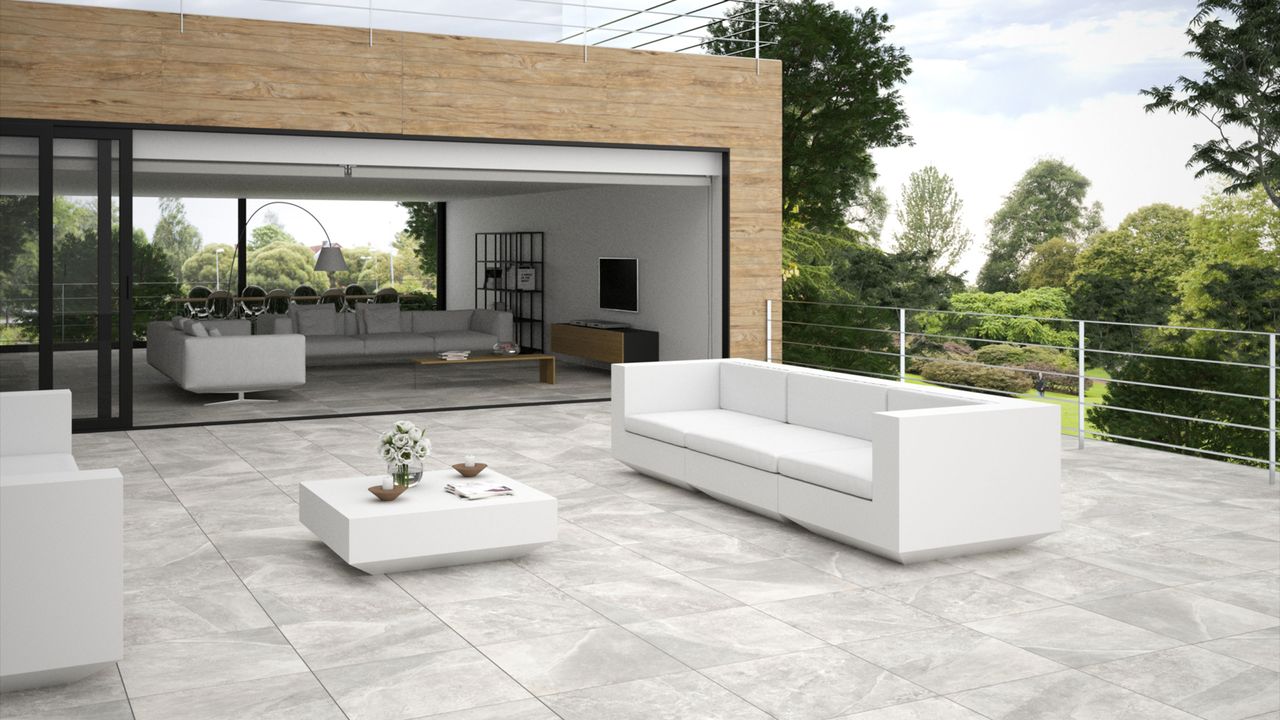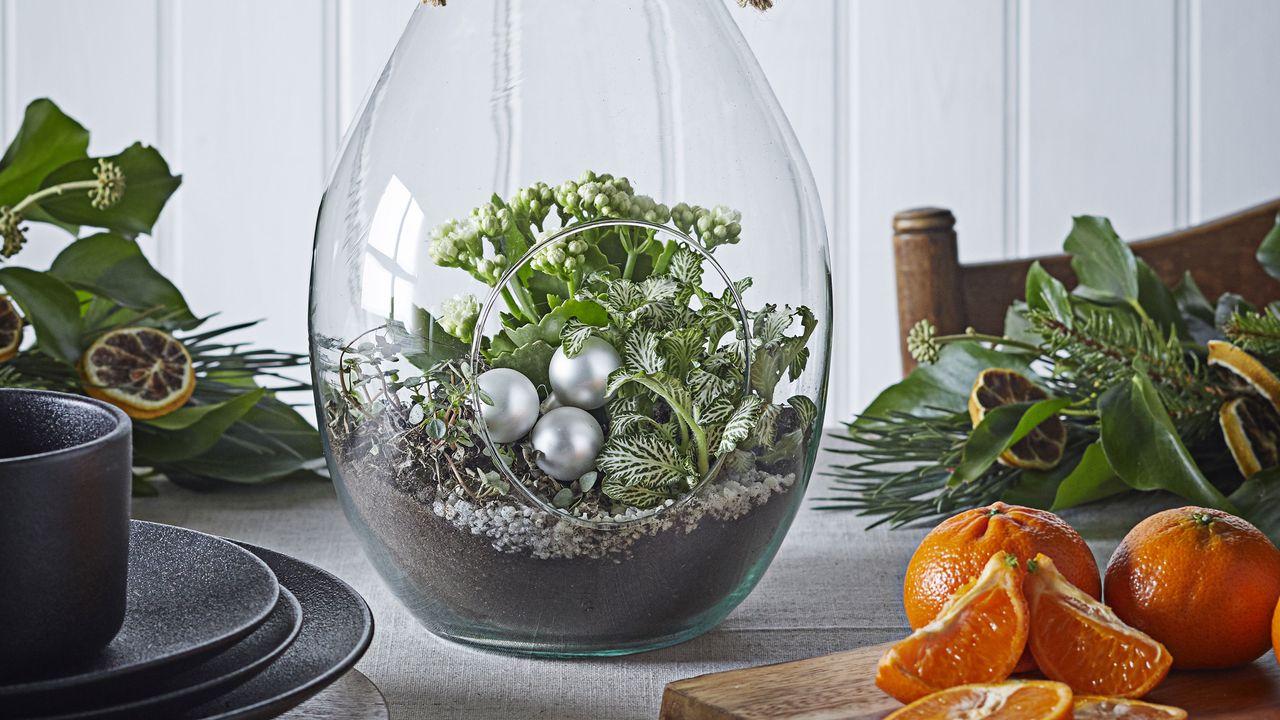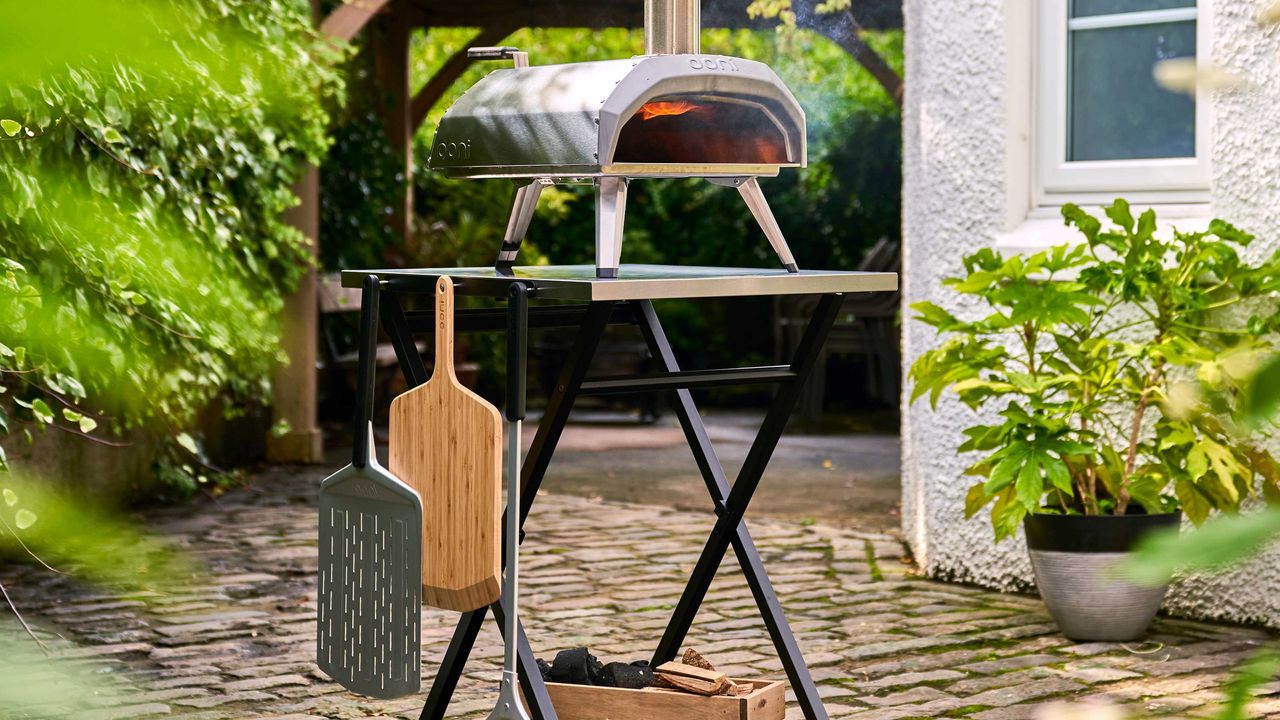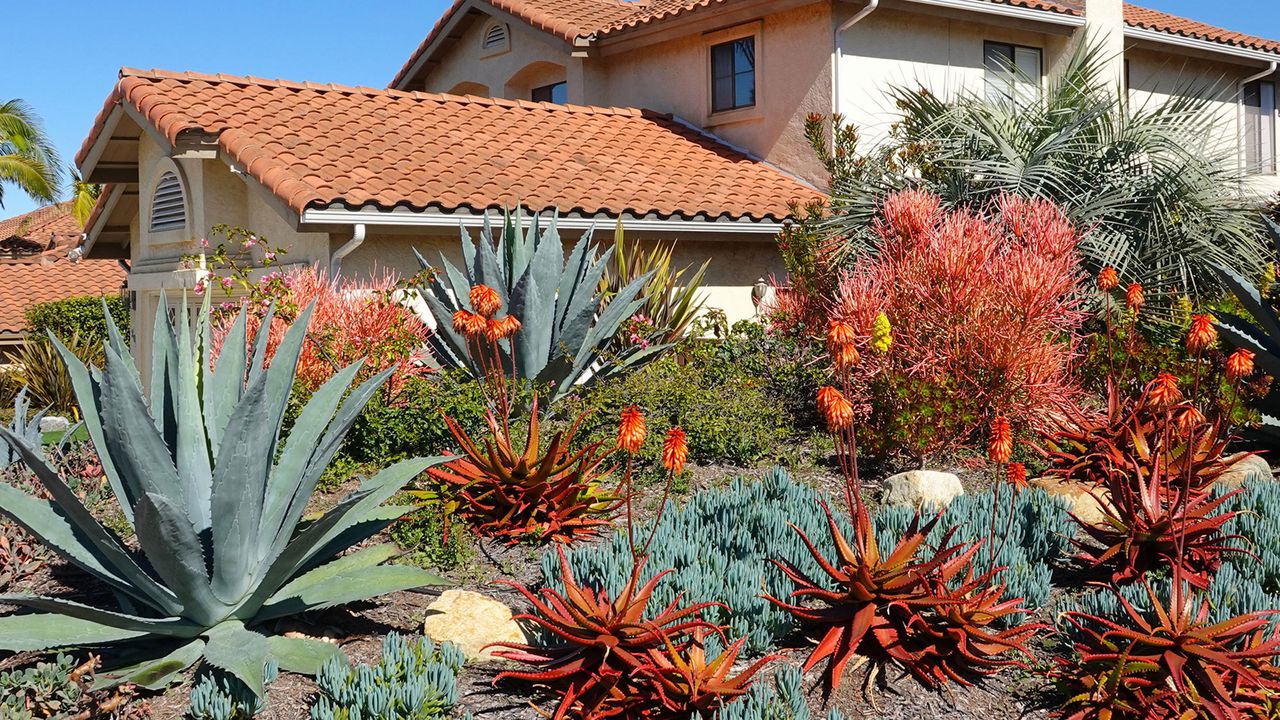Garden path ideas: 33 pretty and practical walkways for your yard
Whether you're looking for a cheap DIY solution or something more luxe, these garden path ideas will help you explore your plot in style
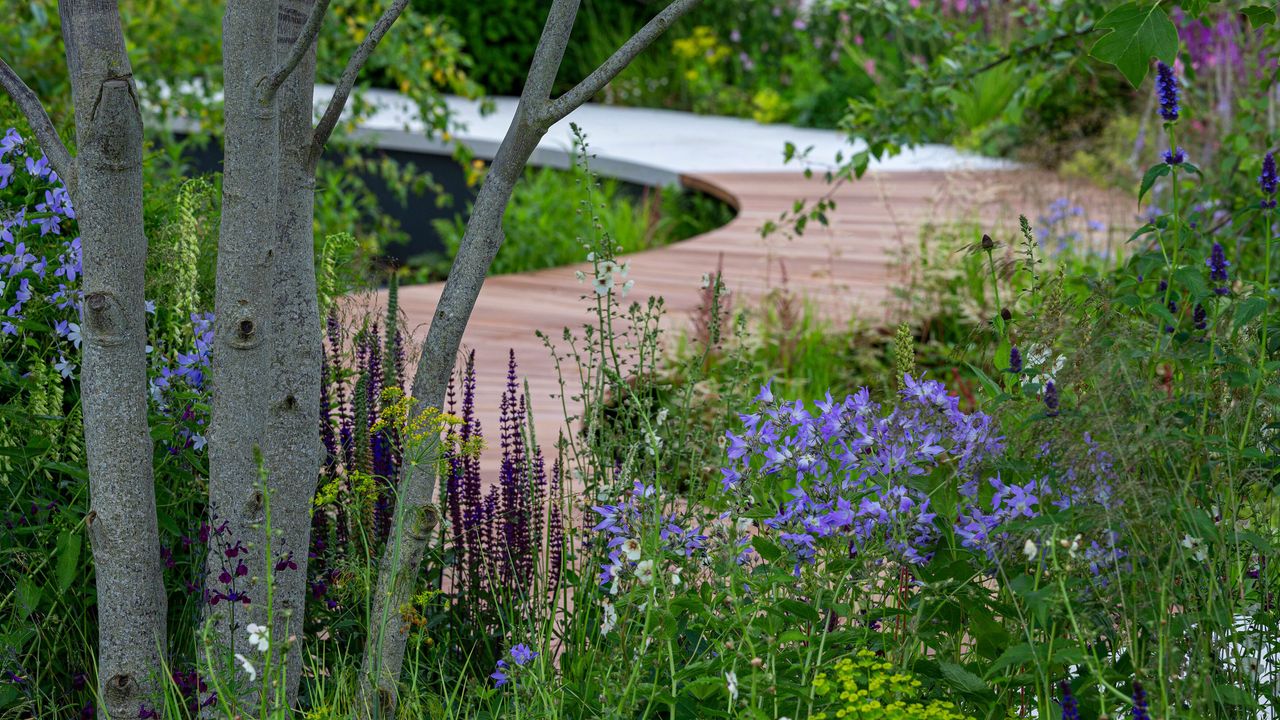
When it comes to getting from A to B, our garden path ideas provide the balance of practicality and style that every plot needs. They're a crucial feature for exploring your backyard and can take many different guises.
Garden paths largely affect how a plot is experienced, as they map out the journeys you'll take around it. Whether it's following a meandering trail of gravel that disappears into lush greenery, or stepping out onto a sleek boardwalk that leads to smart decking, the type of path you choose and how it moves through the space can give your garden a whole new perspective.
If you're looking for a design to match formal landscaping ideas, a smooth, paved surface with clean, straight edges will help create a simple but elegant style. Fancy something a little more exotic? Then a walkway of rugged wooden sleepers will help conjure up hot climes and highlight a mass of foliage too. Whatever type of material or approach you choose, it's a great opportunity to reimagine and pep up your outside space.
33 beautiful garden path ideas for navigating your plot
If you're after stylish garden path ideas, then you've come to the right place. Whether you're looking for a design in timber or brick, gravel or stone, you'll find something to suit from these looks.
1. Divide up your borders with mini brick paths
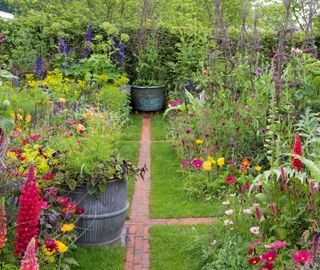
Narrow pathways divide up this gorgeous garden
This colorful, bloom-filled display will bring joy to any onlooker, and the narrow brick pathways perfectly fit the relaxed vibe.
Not only do the straight lines give the scene a sense of structure, but by splitting billowing borders up in this way, it also means the flowers can be appreciated from all angles. What's more, maintenance will be much easier.
We like how the large metal planters have been dotted throughout the scene too, creating focal points that enhance the feeling of vintage charm. Our garden planter ideas feature has more lovely looks if you're after more inspo.
2. Reflect back the view with a mirrored sculpture
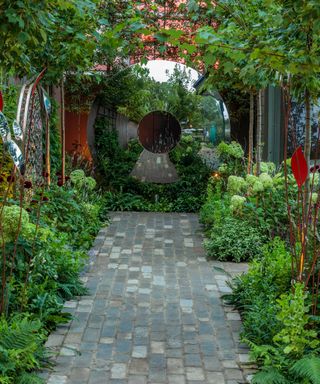
'Torus' by David Harber reflects back this cobbled pathway
Small gardens in particular will benefit from the impact of a garden mirror idea or two. They're great for enhancing the sense of space, creating intriguing illusions, and doubling up beautiful views.
Try positioning one at the top of a path – the blurring of boundaries offers a striking impact and will make anyone look twice. There are plenty of designs to choose from, from antique-effect to window styles, but we especially love this sculptural piece with its elegant convex curves.
3. Choose modern metallics
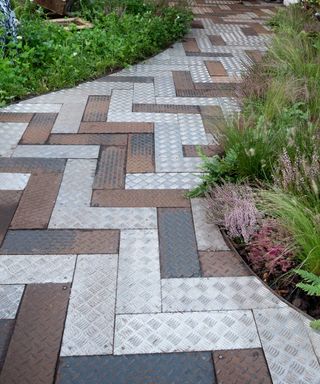
These metallic tiles offer an industrial edge
Bring a sense of industrial-chic to your garden path ideas by opting for metal plates. If you're looking for something fresh and unique for a modern garden, it's a great approach to go for.
Use a mix of colors for an eye-catching contrast and get creative with patterns. Chevrons, as seen here, are particularly effective.
Keep the look balanced by lining with soft, green foliage. Ornamental grasses and ferns make good picks. We also like how the heather in this scene complements the warm-toned patina amongst the tiles for a cohesive finish.
4. Go for soft curves and mixed materials
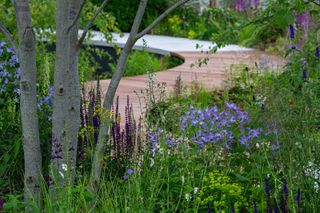
'The Cancer Research UK Legacy Garden' by Tom Simpson for RHS Hampton Court Palace Garden Festival 2021
Using curves in your garden path ideas will allow you to take a more relaxed pace when it comes to getting around your plot. Whether you're meandering across a lawn or through your flowerbeds, it will give you the chance to slow down and really embrace your natural surroundings. Plus, curves are good for widening the sense of space.
This is a good approach for landscaping around trees, too, especially if you already have some established in your backyard. Weaving between silver birches, acers, or blossoms will make you feel like you're journeying through your very own private woodland.
And, if you're looking for a more unique look, consider using more than one material. This design merges both deck and pale paving for a modern result.
5. Add gorgeous greenery between pavers
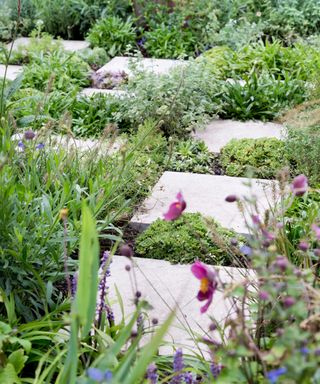
These stepping stones are brought to life by vibrant planting in the 'Green Sky Pocket Garden', designed by James Smith, at Chelsea Flower Show 2021
A walkway of sleek paving can look super smart, but if you prefer a more relaxed look, why not bring some greenery into the mix?
Positioning pavers further apart to create some fun stepping stone ideas will instantly evoke a sense of play in both adults and children. And of course, planting up the gaps provides texture, color, and even scent. It's also great for encouraging more pollinators to your plot.
6. Zigzag paths through planting
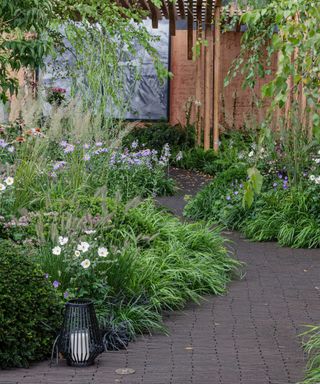
'The Florence Nightingale Garden: A Celebration of Modern-Day Nursing', designed by Robert Myers, at RHS Chelsea Flower Show 2021
Do you have borders and flowerbeds to be proud of, or perhaps a few trees? Rather than following straight lines when it comes to your paths, consider zigzagging them through and around your garden. That way, you can stroll at ease, taking in the luscious greenery and blooms – the perfect way to unwind after a long day.
An intricately-interlocking design of narrow, dark-toned pavers adds another layer of visual interest in this show garden at RHS Chelsea Flower Show 2021. It also makes a gorgeous contrast against vivid green grasses which creep over the edges and soften the overall look.
Bring path lighting ideas into the mix too – that way you can enjoy journeying through your plot even when night falls.
7. Keep it natural

'Bodmin Jail: 60° East – A Garden Between Continents', designed by Ekaterina Zasukhina with Carly Kershaw for RHS Chelsea Flower Show 2021
Getting back to basics with a nature-inspired scene is becoming increasingly popular in garden design. It's understandable – what could be more relaxing than a slice of the great outdoors right on your very own doorstep?
Take this plot, for instance. Its naturalistic composition, striking boulders and soothing waterfalls are brought together in a gorgeous vista reminiscent of the Ural Mountains. A relaxed gravel pathway makes the perfect fit as it mirrors the tones of the rocky landscape and weaves through the space.
Love the look? You might like our landscaping ideas with rocks, too.
8. Use glass bottles for an eye-catching edge
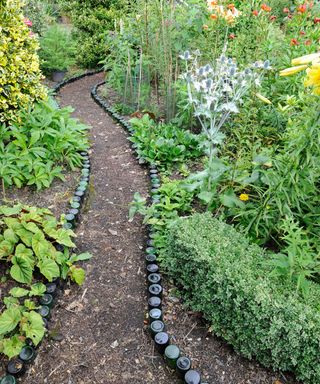
A budget-friendly trick for adding definition to a path
Adding an edge to a path will always give it more definition, resulting in a smarter appearance. What's more, a raised edge can help with maintenance too, as it will keep materials such as gravel and bark chips away from lawns or flowerbeds.
There are plenty of edging styles to try – from smart stone to modern metal. But if you're on the lookout for cheap landscaping ideas, then this approach might be the way forward.
It's simple – just save old glass bottles then bury them halfway into the soil either side of your walkway. The result feels eclectic and artsy and will give even the simplest of paths a more orderly look.
9. Create a sense of intrigue
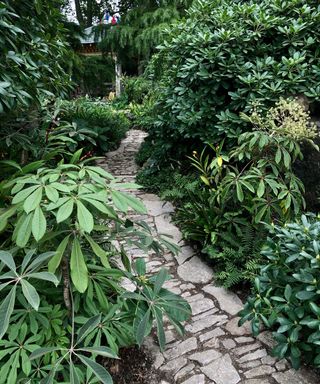
'The Trailfinders’ 50th Anniversary Garden', designed by Jonathan Snow for RHS Chelsea Flower Show 2021
A natural stone path weaving through architectural foliage will bring a tropical garden vibe to any plot.
The mosaic effect of this stone pathway adds a textural contrast against surrounding ferns, rhododendrons and Himalayan pines. What's more, the walkways criss-cross one another which encourages guests to really explore.
Positioning a summer house or even a humble garden shed at the end of the path will up the sense of intrigue further, especially if glimpses of its structure can be spotted through the greenery.
10. Walk alongside water
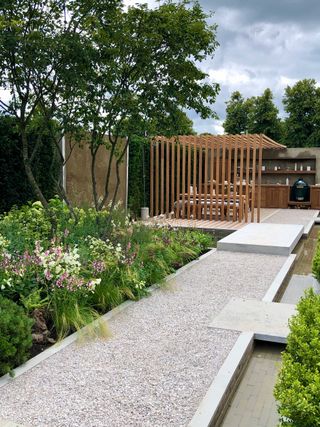
'The Viking Friluftsliv Garden' designed by Will Williams for RHS Hampton Court Palace Garden Festival 2021
If you have an outdoor living zone that's positioned away from the house, then you'll need a sturdy and stylish path to get there. Whether it leads to an outdoor kitchen, dining area, or seating spot complete with fire pit and sofa, it's bound to get a lot of traffic.
A stretch of pale gravel will do the job well, is low-maintenance, and won't get slippery when it's wet. Add sleek paved garden edging for a smarter look, as seen above, then border with beautiful plants.
You can also get creative with water or ponds – a narrow strip alongside this walkway makes a lovely feature. We especially like how it then channels right under the path towards a statement water wall to the left, creating a more distinct zone for the kitchen and seating spot.
11. Go for laid-back logs for your veg patch
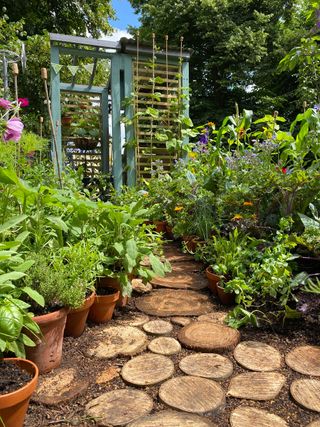
The log pathway in the 'Friends of Ascot' allotment at RHS Hampton Court Palace Garden Festival 2021
If your plot includes kitchen garden ideas, then walkways are a must for easy maintenance and harvesting.
The relaxed style of this log pathway is full of natural charm and is also a great approach if you're after a budget-friendly solution. The difference in log sizes only adds to the laid-back appeal, and we love how the warm tones make it feel even more inviting.
Try recreating the look between your raised beds of ornamental veg or fragrant herbs and flowers, or use to get to and from the shed.
12. Reclaim or upcycle
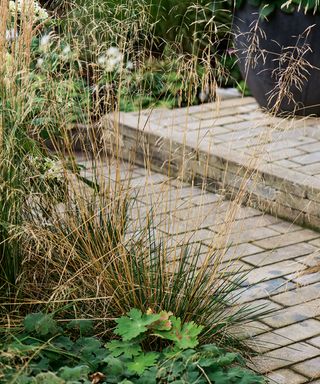
Choose reclaimed bricks for an eco-friendly option
Use recycled materials for your path to dress your outdoor space in a more eco-friendly way. Incorporating reclaimed or upcycled items into your design not only creates a unique feature for you to enjoy, but it also prevents that item going into landfill.
Ask your garden designer to choose a concrete mix that uses recycled aggregates and replaces Portland cement with materials that would otherwise go into landfill. You could also re-use concrete pavers, flagstones, bricks and cobbles wherever possible.
We have more tips on how to create a sustainable garden in our guide.
13. Lower your carbon footprint

Lower your carbon footprint with Old Town ECO Weathered Limestone pavers from Bradstone
Here's another option if you're looking to up your garden's eco-credentials...
The trend for smart low-carbon homes is really taking off, and this of course extends to our gardens too. There's a real push now to make pavers using less carbon, so do your research and choose the most eco option you can find. This means you can do more for the environment while also improving the look of your garden with the very latest designs.
Bradstone ECO products, for instance, have a reduced carbon footprint of more than 20%. This equates to a carbon saving equivalent to that generated by three mature trees over a year.
14. Create an enchanting archway of climbing plants
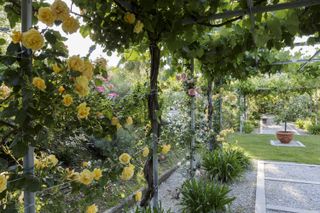
This pretty pathway is full of romance
Bloom-covered archways are a fabulous way to elevate a path and make it feel magical. And there are plenty of best climbing plants to pick from.
Roses or wisteria will always look lovely trained up and over a pergola or a series of arbors, as will fragrant honeysuckle. A look like this will make journeying through your plot a total joy – why not position a seating space at the end to make the most of the view?
15. Journey across your pond
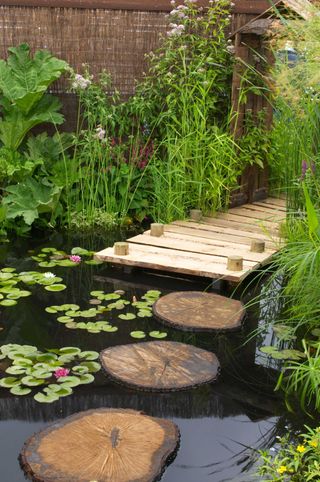
Walking across water can evoke a soothing vibe
If you've graced your backyard with garden pond ideas, then consider adding a pathway across the top. Whether you go for a more traditional bridge design or a stepping stone walkway like this, it'll make the scene feel more interactive and adventurous. Plus, it will allow you to appreciate all the sensory benefits that water has to offer to a plot, especially if you bring in lots of the best pond plants.
Just be sure to keep walkways like this clean, especially in winter when wet conditions can lead to a build up of algae. A slippery path across water can turn into a hazard, especially if there are young children around.
16. Line with color
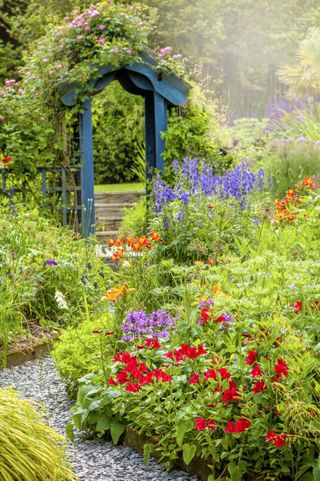
We love how this path weaves around vibrant borders
You can plant a sea of color around your path for a sensory experience. Planting en masse is especially effective – think bright tulips, echinacea or nasturtium. The bees and butterflies will love it too.
If you're after texture as well as color, add ornamental grasses to the mix. Try miscanthus 'Indian Summer' for its flame-hued stems and soft, feathery tops.
Consider bringing a garden arbor into the scene too. They are a fabulous way to frame the start of a pathway and define different garden 'rooms'.
17. Experiment with scent

A small slate path lined with lavender has tons of appeal
For paths that aren't used as often, try adding low-growing herbs such as thyme or wild chamomile. Tuck the plants in-between slate, stones or slabs for a rustic, cottage-garden style look, which will release a beautiful fragrance as you pass by.
Don't forget about lavender, too, which looks lovely as an edging plant. It will add a welcome splash of color along with its relaxing scent. Our guide on how to grow lavender has all the expert tips you'll need.
18. Make a tunnel of greenery

This green willow tunnel adds drama to the space
If you're after something dramatic, why not create a tunnel-like walkway of trained trees? It will take a little while to establish, but the results will be well worth it. The crab apple allée at Oak Spring, by garden designer Rachel 'Bunny' Mellon, is a stunning example.
For a quicker approach, you can make a living willow tunnel. You can buy willow rods or whips from specialist stores, then it's simply a case of pushing them 12in (35cm) or so into grass- and weed-free ground and loosely tying the tops together to form an arch (where they will naturally graft together over time). It's best to do this in winter to early spring, as advises the RHS.
New green shoots will soon appear. You may need to trim it back a few times over summer to maintain a neat shape.
19. Add instant character with cobbles
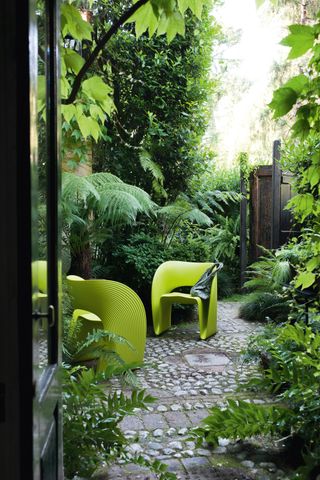
Want to inject some charm and mystery into your plot? Then a freeform mix of reclaimed cobbles and paving will create a tapestry of texture that will only get richer as moss and lichen take hold.
Architectural salvage yards are great hunting grounds for suitable materials. Think carefully how best to arrange your finds; a snaking route works well with these smaller components.
You may also wish to emphasize a particular section of your path or a specific corner – try laying a square of paving and fill in with a symmetrical pattern, or concentrate a particular type of paviour or stone in one area.
Once happy with the design, choose smooth, sculptural seating for an uber-chic finishing touch. You can find plenty more gorgeous picks in our best garden furniture buying guide.
20. Try a raised boardwalk
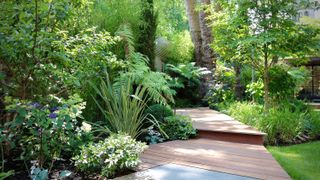
This pathway has a jungle-like vibe, designed by Cityscapers
Add to jungle-like gardens with a series of slick, wooden deckboards that weave through densely planted borders. Designed by Cityscapers, this garden is made even more dramatic by the walkways being set on an angle, at varying levels.
The rich, red tones of the timber are enhanced by the rusty Corten steel risers and are the perfect complementary color for the lush green planting.
21. Illuminate the way
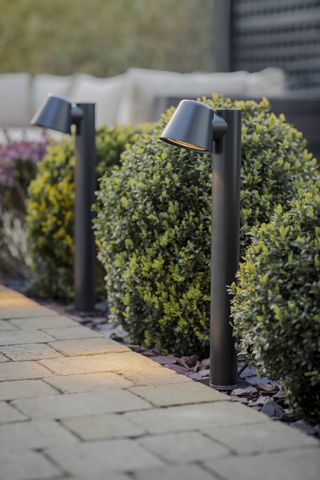
Add some drama to straight or curved garden paths with a line of outdoor lighting – these ones will look good both day and night. Made from powder-coated steel their tall, slender design and smooth carbon finish blend effortlessly with simple, clipped box hedging.
When switched on, the neatly concealed lamps shine pools of light down on to the paving, safely guiding the way and adding an inviting touch too. Mains powered, these lights will need installing by a qualified electrician.
22. Choose playful stepping stones
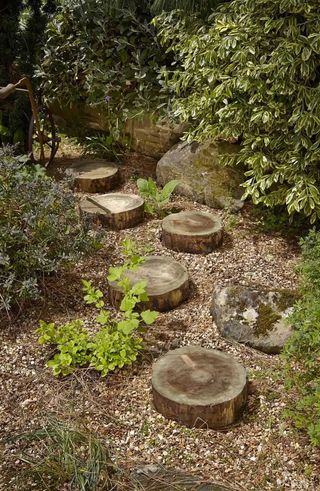
Conjure up that Secret Garden feel with a series of log stepping stones. Look for ones like these which are made from soft timber and treated to last up to 15 years – they will add a magical touch to a secluded corner. Alternatively, it's a great way to recycle if you're cutting down an unwanted tree in your yard, plus will save you the cost of buying new materials.
With little installation required, wind them in and amongst tall shrubs, tree trunks and ornamental grasses to create a meandering pathway. Nestle them into a bed of gravel or bark chippings, making sure they are level and a comfortable 'stride' apart. And what's best is that you can easily lift and move them whenever you fancy.
23. Weave with gravel
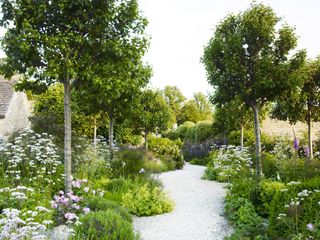
An enchanting walkway designed by Jinny Blom
Serene and effortlessly sophisticated, this white gravel path takes on an almost ethereal charm, winding its way between these flowing borders. Designed by Jinny Blom, it's hard to resist finding out exactly where the trail leads.
Perhaps the secret to its success is the contrast of the closely packed planting in vibrant shades of green and white against the ribbon of tiny, white stones. It perfectly shows how a cool and romantic garden can have a contemporary edge too.
If you like the look, you might like our garden gravel ideas.
24. Dot them with light
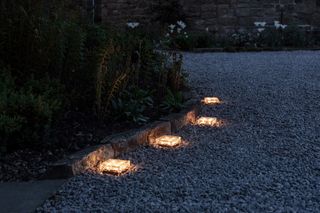
These LED cube garden path lights are from Lights4fun
Perfect for outlining the curviest of garden path ideas, these neat, little lights are solar powered. Thanks to their inbuilt sensor they will turn on at dusk and give out a warm and welcoming glow.
Made from ice-effect glass they are robust enough to be left out all year round. Simply place one every 20in or so along the edge of the path – they can be easily moved if needed.
Looking for more solar-powered solutions? Our buying guide to the best solar lights is full of top picks.
25. Combine pavers with pebbles

Super-straight garden paths don't have to be boring. Instead, treat them as a chance to play with different materials and to create bold patterns. Here smooth, black granite planks with their crisp, sawn edges emphasize the width of the walkway and have been repeatedly divided with rounded, white pebbles.
The effect is contemporary, truly stunning and far from dull.
26. Build a hassle-free boardwalk
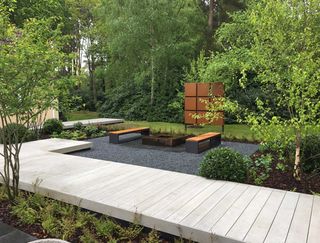
Smoked Oak boards from Millboard
There's something adventurous about a boardwalk and what could be better than having one in your own garden? Cool and contemporary, they make a striking statement, sound great underfoot and, when made from composite decking, they need little upkeep too.
Engineered from a mix of recycled wood fibres and plastics, these boards have all the grain and texture of natural timber and resist the growth of slippery moss and algae.
27. Mow your own
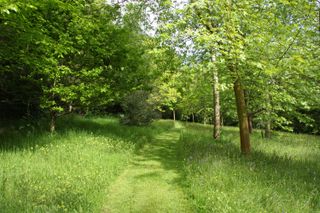
This beautiful garden was designed by Rebecca Smith Garden Design
Your garden paths don't have to be paved, or even hard, underfoot. And, often the most enchanting are those that appear to be completely spontaneous.
What could be more charming than a mown path through a wildflower meadow? Quick and easy to do, you can make the route as twisty or direct as you like. Be kind to your best lawn mower by creating your path while the grass is low and repeating fortnightly.
Alternatively, you may want to strim long grass first (you can find the best strimmer in our guide), before mowing neatly. Just check the route is free of wildlife before you start.
28. Go for a lavish pattern
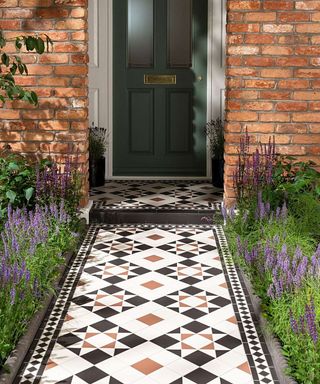
Osterley Terracotta Tile from Topps Tiles make a bold and stylish statement
Take a design tip from the Victorians and use garden paving that's bound to get noticed, especially when used as an elegant pathway for your front garden.
Set on the diagonal and featuring just three different colors, a look like this would have traditionally been featured leading up to the front door. But, there is no reason why it wouldn't work in the back garden, guiding the way to your patio or a secluded seating area.
Get the full formal effect by outlining with border tiles with rope edging for a real sense of occasion.
29. Choose a 'broken edge'
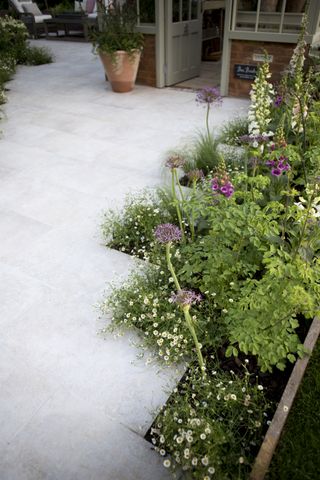
Blending plants and paving can be a tricky business – straight-cut edges can look harsh and formal while no edges at all can be plain messy. So how about this for a stylish compromise?
In this garden, pale porcelain paving has been laid on the diagonal with deliberately staggered edges. This jagged arrangement enables the softly planted, billowing borders to spill out onto the stone, blurring the sharp lines and creating a more relaxed yet still elegant look.
30. Show off timber sleepers
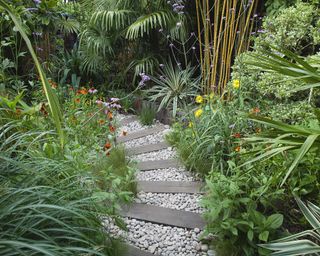
A characterful walkway made from sleepers
Robust and industrial, garden sleepers have an undeniable charm and look great interspersed with gravel for a path.
Alternatively, patchwork different sized lengths together, staggering the joins to create a pathway full of character. Vary the width of the path and create sweeps and curves to help create a sense of movement. Don't try to be too intricate with the design though, as the end result will just appear fussy.
You can find more garden sleeper ideas in our feature.
31. Step it up
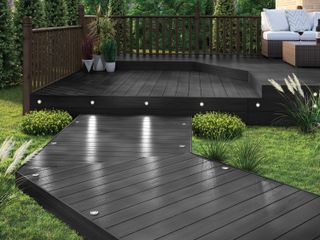
These Eva-Last composite deckboards from Wickes have been combined with LED deck lights
Changing direction and levels are great ways to add interest to any garden path, but it can look particularly effective when the path is made of composite decking.
Sleek and dark in tone, the slim wood-effect deckboards highlight these different planes and inset LED lights add extra drama too.
Plan any joins carefully to make sure the boards are neatly mitred, sit level and that they are well-supported by the joists underneath. Covering the edges with matching fascia boards will also ensure the supporting joists remain neatly hidden.
Our garden steps ideas feature has more lovely looks.
32. Try a timelessly intricate style
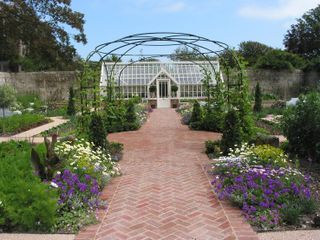
These beautiful handmade brick pavers are from York Handmade Brick Company
Handcrafted brick pavers are a thing of real beauty and will instantly bring warmth, texture and a sense of heritage to any garden.
Found in the kitchen gardens of yesteryear, these baked clay units can be laid in endless patterns – from chevrons, Soldier course, herringbone to basketweave – and will prove as elegant and mesmerizing as any designer planting scheme. They're a garden feature to treasure for years.
33. Frame a pathway

We adore these smart painted obelisks from the Wooden Obelisk Company
Adding height along a path is a nifty trick to make any space look and feel much larger. From rows of stately trees and clipped hedges to elegant obelisks, the effect is to increase the sense of perspective, helping to visually 'stretch' the view ahead.
In this idyllic Cotswold garden, the flagstone paving gently leads to the courtyard beyond, while three pairs of handcrafted obelisks add structure and shape to the herbaceous borders on either side.
What is the cheapest way to make a garden path?
One of the cheapest ways to make a garden path is to use reclaimed bricks, as Gardeningetc's Amy Cutmore explains. 'If you are resourceful, you can create a garden path for next to nothing,' she says. 'During lockdown last spring, I put a shout out on my village's community Facebook group, asking for old house bricks. I had an amazing response, and collected hundreds of free bricks from locals keen to get rid of them.
'Many were caked in dirt or paint, but after a good hose down with a pressure washer, they looked great. I then dug out a route for the path, laid some ground cover sheeting to stop any weeds from growing up, and put sharp sand on top.
'Next, I arranged the bricks in a pattern, embedding them in the sharp sand, and filled the gaps between with some old gravel that had previously formed our garden path.
'We now have two beautiful and rustic paths – one to our front door and one to the garden shed. And all we had to buy was some membrane – a kind neighbor even gave us the sharp sand left over from a building project!'
Mowing garden path ideas through grass, or opting for pea gravel are other low-budget solutions. Looking for more cheap garden ideas? You'll find plenty in our guide.
What is the best gravel for a garden path?
There are many types of gravel available for walkways, but make sure you pick with comfort in mind as well as style.
A medium-sized gravel of around 10mm (a little over 3/8in) is considered the best choice. Go for varieties with smooth, rounded shapes where possible, for maximum comfort underfoot.
When it comes to color, pick tones that match other areas in your garden for a cohesive feel. Using a local stone will often add an extra special touch (and will be cheaper, too).
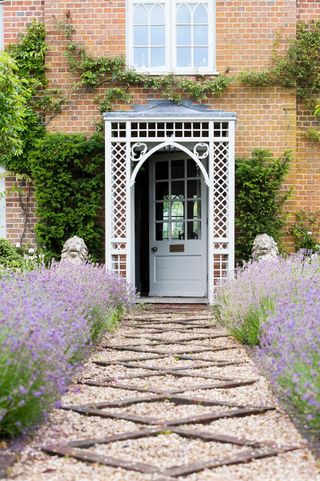
Decorative brickwork adds interest to this gravel path
What is the best material for walkways?
From gravel and natural stone, to slate, brick or timber, there are plenty of materials to use for a walkway. Bear a few things in mind when deciding the best, such as your budget, the local climate, and how the path will be used.
Brick tends to be a good all-rounder, as it's durable, attractive, and relatively inexpensive. Be careful in shady or damp conditions though, as brick paths can become slippery with moss – as can walkways made from decking.
Natural stone such as slate is a stylish and hard-wearing choice, but often expensive to install. Gravel is great as a more affordable option, although make sure to edge your pathway to avoid loose stones being knocked onto lawns.
Wax polymer is a good, yet perhaps less-known choice for larger plots. A combination of decomposed granite and wax, it results in 'a dustless, durable, and aesthetically pleasing pathway that’s especially suitable for use in patios and nonlinear, sloped paths,' says Urdesignmag.
'Wax polymer is also easy to maintain and won't get muddy, which is why it's such a popular material in golf courses', they add.

Jill puts her love of plants and all things garden related down to the hours spent pottering around with her Nan and Grandad when she was little. Today she is lucky enough to have a garden of her own in Surrey, England, and spends much of her time writing about them too.
